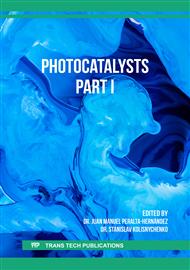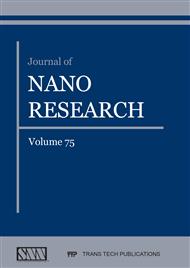[1]
E. Albiter, A. S. Merlano, E. Rojas, J. M. Barrera-Andrade, Á. Salazar, and M. A. Valenzuela, Synthesis, Characterization, and Photocatalytic Performance of ZnO–Graphene Nanocomposites: A Review. J. Compos. Sci. 5 (2021) 4.
DOI: 10.3390/jcs5010004
Google Scholar
[2]
S. Rajendrachari, P. Taslimi, A. C. Karaoglanli, O. Uzun, E. Alp, G. K. Jayaprakash, Photocatalytic degradation of Rhodamine B (RhB) dye in waste water and enzymatic inhibition study using cauliflower shaped ZnO nanoparticles synthesized by a novel One-pot green synthesis method. Arabian Journal of Chemistry, 15 (2021) 103180.
DOI: 10.1016/j.arabjc.2021.103180
Google Scholar
[3]
P. Basnet, D. Samanta, T. I. Chanu, J. Mukherjee, S. Chatterjee, Tea-phytochemicals functionalized Ag modified ZnO nanocomposites for visible light driven photocatalytic removal of organic water pollutants. Mater. Res. Express 6 (2019) 085095.
DOI: 10.1088/2053-1591/ab234e
Google Scholar
[4]
U. Akpan, B. Hameed, Parameters affecting the photocatalytic degradation of dyes using TiO2-based photocatalysts: A review. J. Hazard. Mater. 170 (2009) 520–529.
DOI: 10.1016/j.jhazmat.2009.05.039
Google Scholar
[5]
J. Peral, X. Domènech, D.F. Ollis, Heterogeneous Photocatalysis for Purification, Decontamination and Deodorization of Air. J. Chem. Technol. Biotechnol. 70 (1997) 117–140.
DOI: 10.1002/(sici)1097-4660(199710)70:2<117::aid-jctb746>3.0.co;2-f
Google Scholar
[6]
F. Zhang, J. Zhao, T. Shen, H. Hidaka, E. Pelizzetti, N. Serpone, TiO2-assisted photodegradation of dye pollutants II. Adsorption and degradation kinetics of eosin in TiO2 dispersions under visible light irradiation. Appl. Catal. B 15 (1998) 147–156.
DOI: 10.1016/s0926-3373(97)00043-x
Google Scholar
[7]
S. Shinde, C. Bhosale, K. Rajpure, Photocatalytic degradation of toluene using sprayed N-doped ZnO thin films in aqueous suspension. J. Photochem. Photobiol. 113 (2012) 70–77.
DOI: 10.1016/j.jphotobiol.2012.05.008
Google Scholar
[8]
J. Chang and E. R. Waclawik, Facet-controlled self-assembly of ZnO nanocrystals by non-hydrolytic aminolysis and their photodegradation activities. CrystEngComm, 14 (2012) 4041–4048.
DOI: 10.1039/c2ce25154j
Google Scholar
[9]
Y. H. Mohammed, Fabrication of n-MgZnO/p-Si heterojunction diode: Role of magnesium doping. Superlattices and Microstructures, 131 (2019) 104-116.
DOI: 10.1016/j.spmi.2019.06.001
Google Scholar
[10]
S. Sakrani, N. Jamaludin, R. Muhammad, Y. Wahab, A. K. Ismail, S. Suhaimi, and Y. H. Mohammed, Effect of gas flow rate on structural properties of zinc oxide nanowires grown by vapor-solid mechanism. AIP Conference Proceedings, 1733 (2015) 020040.
DOI: 10.1063/1.4948858
Google Scholar
[11]
M. R. Alenezi, S. J. Henley, N. G. Emerson, S. R. P. Silva, From 1D and 2D ZnO nanostructures to 3D hierarchical structures with enhanced gas sensing properties. Nanoscale, 6 (2014) 235−247.
DOI: 10.1039/c3nr04519f
Google Scholar
[12]
M. R. Alenezi, A. S. Alshammari, P. D. Jarowski, Talal H. Alzanki, S. J. Henley, S. R. P. Silva, ZnO Nanodisk Based UV Detectors with Printed Electrodes. Langmuir, 30 (2014) 3913– 3921.
DOI: 10.1021/la500143w
Google Scholar
[13]
M. R. Alenezi, A. S. Alshammari, K. D. G. I. Jayawardena, M. J. Beliatis, S. J. Henley and S. R. P. Silva, Role of the Exposed Polar Facets in the Performance of Thermally and UV Activated ZnO Nanostructured Gas Sensors. J. Phys. Chem. C, 2013, 117, 17850–17858.
DOI: 10.1021/jp4061895
Google Scholar
[14]
M. R. Alenezi, A. S. Alshammari, A. M. Almeshal, M. J. Beliatis, Talal H. Alzanki, S. J. Henley, S. R. P. Silva, A model for the impact of the nanostructure size on its gas sensing properties. Rsc Advances, 5 (2015) 103195-103202.
DOI: 10.1039/c5ra19404k
Google Scholar
[15]
M. R. Alenezi, T. H. Alzanki, A. M. Almeshal, A. S. Alshammari, M. J. Beliatis, S. J. Henley, S. R. P. Silva, Hierarchically designed ZnO nanostructure based high performance gas sensors. RSC Adv., 4 (2014) 49521-49528.
DOI: 10.1039/c4ra08732a
Google Scholar
[16]
Q. Tang, W. J. Zhou, J. M. Shen, W. Zhang, L. F. Kong and Y. T. Qian, A template-free aqueous route to ZnO nanorod arrays with high optical property. Chem. Commun., 6 (2004) 712.
DOI: 10.1039/b313387g
Google Scholar
[17]
W. J. Li, E. W. Shi, W. Z. Zhong and Z. W. Yin, Growth mechanism and growth habit of oxide crystals J. Cryst. Growth. 203) 1999(186.
DOI: 10.1016/s0022-0248(99)00076-7
Google Scholar
[18]
J. B. Liang, J. W. Liu, Q. Xie, S. Bai, W. C. Yu and Y. T. Qian, Hydrothermal growth and optical properties of doughnut-shaped ZnO microparticles. J. Phys. Chem. B, 109 (2005) 9463.
DOI: 10.1021/jp050485j
Google Scholar
[19]
Y. H. Ni, X. W. Wei, X. Ma and J. M. Hong, CTAB assisted one-pot hydrothermal synthesis of columnar hexagonal-shaped ZnO crystals. J. Cryst. Growth., 283 (2005) 48.
DOI: 10.1016/j.jcrysgro.2005.05.048
Google Scholar
[20]
G. A. Gutierrez-Sosa, A. Baraldi, R. Larciprete, S. Lizzit, Impact of defects on the surface chemistry of ZnO(0001 macro)-O. J. Am. Chem. Soc. 124 (2002) 7117−1722.
DOI: 10.1021/ja025904u
Google Scholar
[21]
Lindsay, R.; Michelangeli, E.; Daniels, B. G.; Ashworth, T. V.; Limb, A. J.; Thornton Geistlinger, H. The influence of chemisorption on the defect equilibrium of metal oxide thin films. J. Appl. Phys. 80 (1996) 1370−1380.
DOI: 10.1063/1.362936
Google Scholar
[22]
S. Xu, C. Lao, B. Weintraub, Z. L. Wang, Density-controlled growth of aligned ZnO nanowire arrays by seedless chemical approach on smooth surfaces. J. Mater. Res. 23 (2008) 2072–(2077).
DOI: 10.1557/jmr.2008.0274
Google Scholar
[23]
Z. L. Wang, Novel nanostructures of ZnO for nanoscale photonics, optoelectronics, piezoelectricity, and sensing. Appl. Phys. A: Mater. Sci. Process. 88 (2007) 7-15.
DOI: 10.1007/s00339-007-3942-8
Google Scholar
[24]
A. B. Djurisic, W. C. H. Choy, V. A. L. Roy, Y. H. Leung, C. Y. Kwong, K. W. Cheah, T. K. G. Rao, W. K. Chan, H. F. Lui, C. Surya, Photoluminescence and electron paramagnetic resonance of ZnO tetrapod structures. Adv. Funct. Mater. 14 (2004) 856-864.
DOI: 10.1002/adfm.200305082
Google Scholar
[25]
X. L. Wu, G. G. Siu, C. L. Fu, H. C. Ong, Photoluminescence and cathodoluminescence studies of stoichiometric and oxygen-deficient ZnO films. Appl. Phys. Lett. 78 (2001) 2285-2288.
DOI: 10.1063/1.1361288
Google Scholar
[26]
M. Montero-Muñoz, J. E. Ramos-Ibarra, J. E. Rodríguez-Páez, M. D. Teodoro, G. E. Marques, A. R. Sanabria, P. C. Cajas, C. A. Páez, B. Heinrichs, J. A. H. Coaquira, Role of defects on the enhancement of the photocatalytic response of ZnO nanostructures. Applied Surface Science, 448 (2018) 646-654.
DOI: 10.1016/j.apsusc.2018.04.105
Google Scholar
[27]
S. L. Xiong, J. B. Xi, C. M. Wang, D. H. Xu, X. M. Feng, Z. C. Zhu, Y. T. Qian, Tunable synthesis of various wurtzite ZnS architectural structures and their photocatalytic properties. AdV. Funct. Mater. 17 (2007) 2728-2738.
DOI: 10.1002/adfm.200600891
Google Scholar
[28]
C. S. Rout, S. H. Krishna, S. R. C. Vivekchand, A. Govindaraj, C. N. R. Rao, Hydrogen and ethanol sensors based on ZnO nanorods, nanowires and nanotubes. Chem. Phy. Lett. 418 (2006) 586-590.
DOI: 10.1016/j.cplett.2005.11.040
Google Scholar
[29]
J. Q. Xu, Q. Y. Pan, Y. A. Shun, Z. Z. Tian, Grain size control and gas sensing properties of ZnO gas sensor. Sens. Actuators, 66 (2000) 277-279.
DOI: 10.1016/s0925-4005(00)00381-6
Google Scholar
[30]
A´. Ne´meth, E. Horva´th, Z. La´badi, L. Feda´k, I. Ba´rsony, Single step deposition of different morphology ZnO gas sensing films. Sens. Actuators B 127 (2007) 157-160.
DOI: 10.1016/j.snb.2007.07.091
Google Scholar



